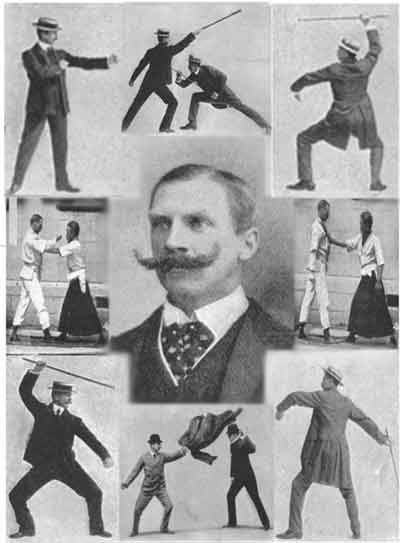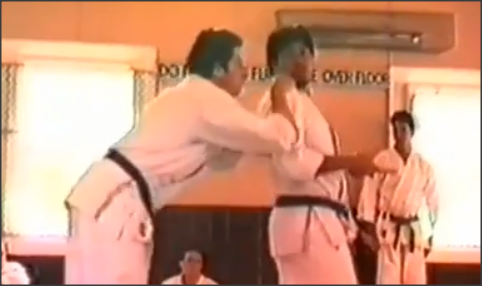It could take some years to develop enough proficiency, awareness and skill to successfully ward off an attacker with only your hands and feet. There is no code of honour that states a karate-ka cannot adapt and use anything about his/her person as an improvised weapon. After all, the traditional Okinawan weapons were simply farm tools or implements that were used daily.
The nature of self-defence dictates that there is no restriction to one’s training requiring a limited use of techniques or skills. Tino Ceberano Hanshi maintains that adapting everything you’ve learned and physical objects around you to the current situation is necessary for survival. The better you can adapt your martial art to the situation, the better for your welfare.
Carrying a weapon for self-defence is illegal but a walking stick, magazine, ballpoint pen, keys, wine bottle, penlight and many other items can be used with some improvisation. The walking stick or cane has been used throughout the ages. It is mentioned in the Bible, was used in ancient Egypt, was toted by Asian monks and carried by Zulus. In 18th century London, a license was required to carry one.
 Baritsu is known as the martial art of gentleman. Created by William Barton-Wright, an English railroad engineer, Baritsu is, practically, the art of self-defense with the walking stick. As early as 1900, the London Free Lance reported that the new school was crowded with students, as follows.
Baritsu is known as the martial art of gentleman. Created by William Barton-Wright, an English railroad engineer, Baritsu is, practically, the art of self-defense with the walking stick. As early as 1900, the London Free Lance reported that the new school was crowded with students, as follows.
“At the school in Shaftesbury Avenue all the most telling strokes that it is possible to make with an ordinary walking stick are explained, illustrated and taught, and the pupil is shown how to best tackle the man – say, a street rough – “who comes at you anyhow with a stick. ”
“Personally, I am of the opinion that every young fellow ought to learn Baritsu, for it appears to be the one the mode of self-defense liable to prove of practical use to any man and at any moment, even to the man who lives, moves and has his being only in this prosaic city of London.”
Canne de combat is a French martial art. As weapon, it uses a cane or canne (a kind of walking-stick) designed for fighting. The French developed the walking stick into a formidable self-defense tool that became known as la canne. Adopted into the traditional savate training halls of the 1800s, it’s remained by the side of the kicking art for more than 200 years.
The walking stick and its close cousin, the umbrella, are favourites of Tino Ceberano Hanshi and he has demonstrated the effective use of the walking stick for many years at demonstrations at Melbourne’s Moomba, Chinatown at Chinese New Year celebrations and on TV back in the days of the Roy Hampson Show on Channel 0 and later the Bert Newton Show on Channel 10.
Many of the skills and principles of the Filipino Martial Arts (FMA) and Japanese weaponry can be applied to the walking stick. Techniques includes throws, locks, strikes and take-downs. Also known as a combat cane, the walking stick with its many style and designs including the handle is an effective weapon in the hands anyone who takes the time to learn its uses, regardless of their age or gender.
Arcanis is the art of the cane. Arch or Arco is the cyclic movement of the object in motion. Cane or Canias hence when relating to its use as an effective weapon or aid to defend…’the Art of the Cane’. Largo Mano means long hand or extended arm and is an important principle of stick fighting.
The cane is an extension of your hand and acts to extend your range. It provides a defensive shield in the radius of your new extended range providing a new enlarged defensive front with an increased reach. Think of it as a feeler, like a blind person finding his way around or much like a crayfish or lobster might use its appendages, essentially using the largo mano principle.
Importantly it acts as a deterrent to someone entering that range with an intended or even unintended provocation. Simply lifting the stick with a pointing action loudly signals a defensive action as a security measure, simply saying “Stop, I have a weapon” to the aggressor.
It’s no different to any animal which makes a noise or alters it body language in answer to the near proximity of a potential predator. Other animals understand the action and take note, or ignore it at their peril then suffer the consequences.
The walking stick is versatile. It can help you to right your balance and you can use it for a slashing downward horizontally or upward swiping blow across bony surfaces. The ability to poke or prod with the stick can cause devastating harm to soft, vulnerable areas allowing real penetration to delicate areas.
The walking stick handle can be used to hook or grab a limb or the neck allowing control of the aggressor. The grappling effect around the ankle to trip or grab a limb has many variations and you’d be surprised how effective this simple weapon can be.
Tino Ceberano Hanshi was shown by his father how to use the walking stick as a weapon at a very early time in his life and stimulated him to explore the diverse use of such a simple instrument. He explored and developed his skills with the walking stick over many years.
Tino Ceberano Hanshi is quick to point out that age is not a barrier to learning to use the walking stick. As well as its self-defence uses, it is helpful in providing balance, stability and an extension of one’s own self as a longer arm or feeler. Even elderly folk who are stiffer and less agile can gain confidence, a sense of security, enhanced mobility and improved balance when instructed to use a walking stick properly.
The IGK is developing a Senior Citizens Training course for exercise and self-defence with its own research development team. This will form a part of the new Goju Kalis section of IGK’s weapons training. It is just one part of the progressive evolution of martial arts development that Tino Ceberano Hanshi has provided for over 50 years respecting but not being rooted to tradition.
